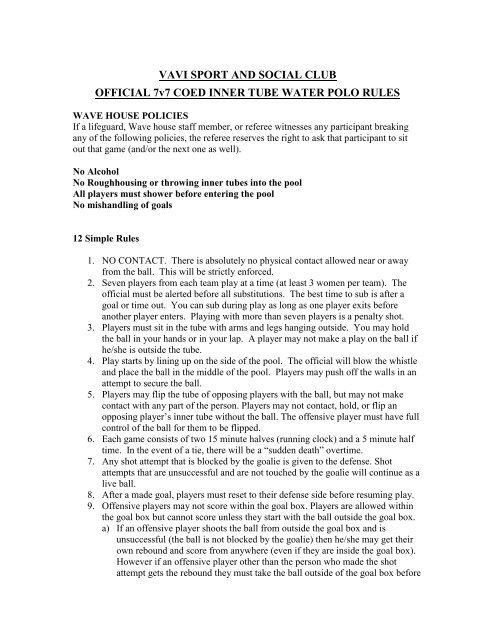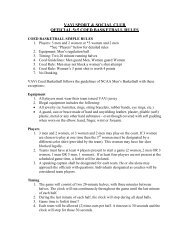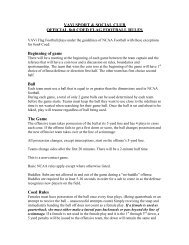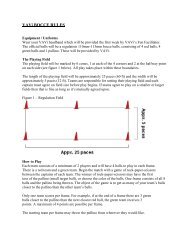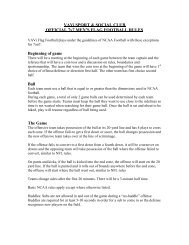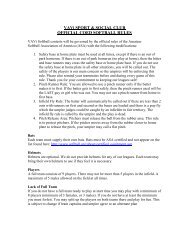7v7 Coed Inner Tube Water Polo Rules - Vavi
7v7 Coed Inner Tube Water Polo Rules - Vavi
7v7 Coed Inner Tube Water Polo Rules - Vavi
You also want an ePaper? Increase the reach of your titles
YUMPU automatically turns print PDFs into web optimized ePapers that Google loves.
VAVI SPORT AND SOCIAL CLUB<br />
OFFICIAL <strong>7v7</strong> COED INNER TUBE WATER POLO RULES<br />
WAVE HOUSE POLICIES<br />
If a lifeguard, Wave house staff member, or referee witnesses any participant breaking<br />
any of the following policies, the referee reserves the right to ask that participant to sit<br />
out that game (and/or the next one as well).<br />
No Alcohol<br />
No Roughhousing or throwing inner tubes into the pool<br />
All players must shower before entering the pool<br />
No mishandling of goals<br />
12 Simple <strong>Rules</strong><br />
1. NO CONTACT. There is absolutely no physical contact allowed near or away<br />
from the ball. This will be strictly enforced.<br />
2. Seven players from each team play at a time (at least 3 women per team). The<br />
official must be alerted before all substitutions. The best time to sub is after a<br />
goal or time out. You can sub during play as long as one player exits before<br />
another player enters. Playing with more than seven players is a penalty shot.<br />
3. Players must sit in the tube with arms and legs hanging outside. You may hold<br />
the ball in your hands or in your lap. A player may not make a play on the ball if<br />
he/she is outside the tube.<br />
4. Play starts by lining up on the side of the pool. The official will blow the whistle<br />
and place the ball in the middle of the pool. Players may push off the walls in an<br />
attempt to secure the ball.<br />
5. Players may flip the tube of opposing players with the ball, but may not make<br />
contact with any part of the person. Players may not contact, hold, or flip an<br />
opposing player’s inner tube without the ball. The offensive player must have full<br />
control of the ball for them to be flipped.<br />
6. Each game consists of two 15 minute halves (running clock) and a 5 minute half<br />
time. In the event of a tie, there will be a “sudden death” overtime.<br />
7. Any shot attempt that is blocked by the goalie is given to the defense. Shot<br />
attempts that are unsuccessful and are not touched by the goalie will continue as a<br />
live ball.<br />
8. After a made goal, players must reset to their defense side before resuming play.<br />
9. Offensive players may not score within the goal box. Players are allowed within<br />
the goal box but cannot score unless they start with the ball outside the goal box.<br />
a) If an offensive player shoots the ball from outside the goal box and is<br />
unsuccessful (the ball is not blocked by the goalie) then he/she may get their<br />
own rebound and score from anywhere (even if they are inside the goal box).<br />
However if an offensive player other than the person who made the shot<br />
attempt gets the rebound they must take the ball outside of the goal box before
making a shot attempt. If the offensive player makes a shot attempt after they<br />
get the rebound and is still inside the goal box it will result in an automatic<br />
turnover.<br />
10. The defense may only have 1 goalie at a time. More than one defensive player is<br />
allowed within the goal box however only the goalie is allowed to block shots. If<br />
a defensive player who is not the goalie and is not directly guarding the offensive<br />
player with the ball blocks a shot, with any part of their body, it will result in a<br />
reset for the offense.<br />
11. All jump balls are given to the defense.<br />
12. Anytime there is a loose ball neither player may hinder the other from getting to the ball.<br />
If one player physically interferes with the other it will result in an automatic turnover.
13.<br />
1. Team Requirements<br />
A team consists of up to 14 players. Small groups of 10 or more are considered<br />
complete teams. Teams must have a minimum of 3 females on the roster.<br />
No more than 7 players are allowed in the pool at any given time (one of which is the<br />
goalkeeper). Teams may play with a minimum of 5 players. The possible<br />
combinations are 4M/3F, 4F/3M, 3M/3W, 2M/3W, 3M/2W.<br />
2. Equipment<br />
VAVi will provide inner tubes and a game ball for each contest.<br />
All jewelry is prohibited and will result in dismissal from the pool. Players will not be<br />
allowed a replacement until the next opportunity for a legal substitution (Section<br />
3).<br />
3. Substitutions<br />
A team must notify the Official of all substitutions. No player may enter the pool<br />
without permission of the Official.<br />
Teams may substitute under the following conditions:<br />
a) After a goal, both teams may substitute<br />
b) After an out-of-bounds infraction, both teams may substitute<br />
c) During a time-out<br />
d) During a live ball. Player must exit before new player enters.<br />
4. Length of Game and Timing<br />
Each half will be 15 minutes in length with a continuous running clock. Half-time<br />
will be 5 minutes. Teams will change ends at half-time.<br />
Each team will be allowed one 60 second time-out per half. Time-outs do not carry<br />
over to the second half. A time-out may be called by any player whose team is in<br />
control of the ball.<br />
To start each half, both teams line up at opposite ends of the pool until the official<br />
drops the ball into the playing area and signals to begin play. On the official’s<br />
whistle, both teams may propel their inner tubes toward the ball. Pushing off the<br />
wall to start is legal.<br />
The Official blowing his/her whistle warrants a dead ball (even if inadvertent).<br />
Tie games in the regular season will be decided by a sudden death overtime.<br />
GOLDEN GOAL!!!<br />
Tie games in the playoffs will be decided by a 5 person shoot out. M-F-M-F-M. Any<br />
player can be goalie. Goalie is eligible to shoot.<br />
5. <strong>Rules</strong> Clarifications<br />
5.1 Free throws are awarded for violations from a point nearest (and behind) the spot of<br />
the infraction. During a free throw, the offense has 5 seconds to pass the ball to a<br />
teammate. A goal may not be scored from a free throw. The defense must remain at<br />
least 3 feet away until the ball is released.<br />
5.2 Goal Box Restrictions:
a) The area that extends 2 meters from the goal line and extends the entire width of<br />
the playing area is the goal box.<br />
b) No offensive player may enter the goal box without the ball. This violation occurs<br />
when any part of the player’s innertube or body breaks the plane of the goal box<br />
without the ball. It is legal to enter the box with the ball.<br />
c) No defensive player, other than the goalie, may remain in the goal box. A<br />
violation occurs when a player purposely attempts to block a shot from within the<br />
goal box. This is to prevent two goalies. It is legal to enter the box to defend a<br />
player with the ball. First violation results in a turnover. Future violations result<br />
in penalty shots.<br />
5.3 Goalie Restrictions:<br />
a) The goalie may not leave his/her tube in an attempt to block a shot from entering<br />
the goal. If the shot is unsuccessful, this will result in a Penalty Shot for the<br />
offended team (see Rule 6.3).<br />
b) After a score, the ball will be put into play by the goalie. The goalie must wait for<br />
the Official’s whistle to re-start play.<br />
c) The goalie can not score a goal.<br />
d) A team may only defend the goal with one goalie (see Rule 5.2.c).<br />
5.4 A goal is scored when a legal shot completely crosses the goal line. A player scoring<br />
a goal must remain in his/her tube until the ball crosses the goal line or the score will<br />
be disallowed.<br />
5.5 Players dribble the ball by pushing it in the water, holding it between their knees,<br />
holding it with 2 hands, holding it with one hand in the air, holding it against their<br />
body, or holding it in their lap. It is illegal to hold the ball completely under the water.<br />
a) Players may not deliberately hold the ball for more than 5 seconds to delay the<br />
game. At the Official’s discretion, a delay of game violation will be issued.<br />
b) Violations result in a free throw for the offended team.<br />
5.6 All players must sit in a horizontal position inside the innertube. If a player falls out<br />
of their tube, the player may not attempt to influence the game in any way. The player<br />
may not make a play on the ball until he/she is properly positioned on the innertube<br />
5.7 A Free Throw will result when the ball passes out of bounds.<br />
5.8 The offsides rule will be enforced for both offense and defense.<br />
5.9 When two opposing players are both in possession of the ball, the ball will be<br />
awarded to the defensive team for a free throw.<br />
6. Fouls and Misconduct<br />
6.1 Players may not hold, push, hit, splash, dunk, or tackle any other players with or<br />
without the ball. This is a NON CONTACT sport. If a player is in control of the<br />
ball, the player MAY NOT be touched. Inadvertent contact will result in a free<br />
throw. Advertent and excessive contact will result in a penalty shot. Flagrant<br />
contact will result in a player ejection and possible suspension from the league.<br />
6.2 By popular demand, you may attempt to flip a person in control of the ball.<br />
Contact may be made with an opponent’s inner tube. Any contact with the<br />
player’s arms, legs, or body is a penalty and will result in a free throw.<br />
6.3 Penalty Shots:
a) Penalty shots shall be taken by the offended player at the 5-meter line.<br />
Defensive players must be at least 3 feet from the shooter and behind or to the<br />
side of the shooter.<br />
b) Offensive players must shoot immediately following the official’s whistle.<br />
No delays or pump fakes.<br />
b) If the result of the penalty shot is not a goal, the ball remains in play.<br />
6.4 A technical foul is a non-contact foul by a player or any behavior deemed by the<br />
Official to be unsportsmanlike. A player that receives an unsportsmanlike<br />
technical will be ejected. For all technical fouls, a penalty shot will be awarded to<br />
the offended team. Any player in the pool at the time of the technical foul may<br />
shoot the Penalty Shot.<br />
6.5 For any flagrant, malicious, or violent fouls, the offending player will be ejected<br />
and a Penalty Shot will be awarded to the offended team.<br />
7. Shootouts (Alternative for Playoffs Only)<br />
7.1 Five players from each team will be selected by the team to shoot<br />
(goalkeepers may be one of the shooters).<br />
7.2 Shooters do not have to have been in the pool at the end of regulation.<br />
7.3 A coin flip will decide which team has the option of shooting first or last.<br />
7.4 Each team has a total of 5 penalty shots and will alternate each shot.<br />
No rebounds are allowed.<br />
7.5 The thrower must wait for the Official to start the play on each throw.<br />
7.6 If the score is tied at the end of the first shootout, another shootout will be<br />
conducted. During the second shootout, the game is won if, after ANY equal<br />
number of shots, the tie is broken. Players who shot in the first round are still<br />
eligible to shoot in the second round.<br />
7.7 Teams must alternate shots on goal between male and female. Possible penalty<br />
shot combinations are M – F – M – F – M or F – M – F – M – F. In the case that a<br />
tie exists after the first 5 penalty shots, the opposite gender will be eligible to try a<br />
penalty shot.<br />
7.8 Shootouts must be agreed upon by both team captains. If there is disagreement, a<br />
sudden death overtime will be played to decide the game.<br />
TOURNAMENT RULES<br />
The top 4 teams advance to the tournament. The standings will be determined by record<br />
(3 points for a win, 1 point for a tie, 0 points for a loss).<br />
In case there is a two-way tie between teams, the following tiebreaker system will be<br />
used:<br />
~Head-to-head matchup<br />
~If there is still a tie or if both teams played each other twice and both have a 1-1 record<br />
we will move on to Head-to-head goal differential (Head-to-head goals scored minus<br />
goals scored against)<br />
~Overall season goal differential (Overall season goals scored minus overall goals scored<br />
against)
~ If no clear winner is established a flip of the coin will establish the winner.<br />
In case there is a three-way tie between teams, the following tiebreaker system will<br />
be used:<br />
~Head-to-head matchup<br />
~ If the winner of the head-to-head matchup can’t be determined (ie. 2 teams played each<br />
other twice or each team has a 1-1 record), then the head-to-head goal differential will be<br />
used and compared for all 3 teams. (ie. Average Goals scored minus average goals scored<br />
against). Whoever has the highest average goal differential will take the higher playoff<br />
seed.<br />
**Average goal differential will be used when two tied teams in the three-way tie played<br />
each other twice. If Team A and Team B played each other twice and Team C only<br />
played each team once, we will use the average score for Team A and Team B’s two<br />
games. To determine this, we will add up the goals scored for both teams in both games<br />
and subtract the goals scored against. This number will then be divided by 2 to determine<br />
the average.<br />
**PLEASE NOTE: If one of these teams in the tiebreaker forfeits anytime during the<br />
season, that game will be counted as a 5-0 loss for the forfeiting team.<br />
If a tie exists at the end of a tournament game the game will be decided by going<br />
immediately into a Shootout.**See Shootouts above.<br />
All other playoff scenarios that occur will be treated on a case-by-case basis by the Sports<br />
Director. The Sports Director has the final say on any disputes and will treat each<br />
situation in the fairest and most logical way.


